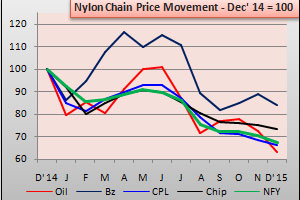
Falling crude oil sets nylon chain on a freefall
YarnsandFibers News Bureau 2016-01-11 12:11:00 – MumbaiThe nylon value chain has lost more than half its values in Asian markets by end 2015 end ever since they were at their yearly peak in May-June. The plunge was triggered by the rapidly falling crude oil prices where in benzene, a refinery product – is closely linked. Caprolactum, a nylon fibre intermediate, is derived from benzene via cyclohexane. Nylon chip, nylon fibre and nylon filament yarn are derived from caprolactum. Thus, the final product costing depends on the movement in crude oil and thereby, benzene markets.
Crude oil prices continued their freefall in December, closing towards the 11-year lows, after the IEA warned that global oversupply might worsen in 2016. Crude oil prices also declined after news that the OPEC was planning to maintain its production near record highs despite depressed prices, as it continued to guard its share in an oversupplied market. Baker Hughes Inc report showed the total rig count at 536 by the end of the month. US crude and Brent price fell 13% and 14% respectively as compared to previous month’s average. From a year ago levels, crude oil prices have lost about 38%.
Benzene prices in Asian markets declined sharply in December following the plunges in crude oil cost amid rapidly weakening demand. Asian marker, FOB Korea was down 5.3% during the month and 16% on the year. Caprolactum values in China eased on languishing demand and expectation of increased supply. The markets were apparently approaching on a bearish note on softening demand, with producers operating at higher rates. Asian caprolactum spot prices fell 3.2% from last month and 34% on the year.
Nylon chip prices fell in December on back of weak caprolactum and falling crude oil prices. Producers carried out low operating rate amid cautious buying sentiment. Demand was lax from nylon fibre makers while nylon yarn makers reduced run rate with cautious mentality. In case of non-textile sectors, meager margins at cord fabric, monofilament and fishing-net yarn markers weakened offtake for chips. Offers for Taiwan-origin chips was down 5.2% from November and 32% from December last year.
Nylon filament yarn markets continued to sustain weaknesses while operating pressure was range-bound as caprolactum and nylon chip prices moderated a bit. Demand was cautious to follow up, resulting in slow liquidity at nylon yarn makers. Meanwhile, demand for staple fiber was slow and that for fishing-net yarn, monofilament and cord fabric was bleak at year-end. In China, semi-dull FDY70D/24F was down 5% from previous month while the year on year fall was 33%.
Courtesy: Weekly PriceWatch Report
Market Intelligence
Ask for free sample Report

experience
Customer Base
dedicated team
Countries Served Worldwide









